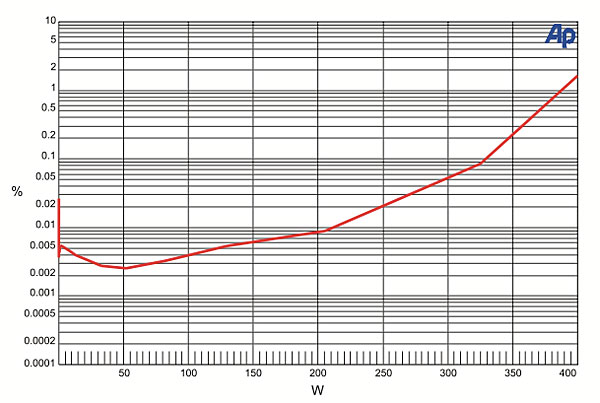ATI AT6005 Amplifier Test Bench
Two channels driven continuously into 8-ohm loads:
0.1% distortion at 328.9 watts
1% distortion at 387.6 watts
Five channels driven continuously into 8-ohm loads:
0.1% distortion at 288.4 watts
1% distortion at 349.8 watts
Frequency response RCA input:
+0.02 dB at 10 Hz
+0.01 dB at 20 Hz
–0.11 dB at 20 kHz
–2.99 dB at 50 kHz
Frequency response XLR input:
+0.02 dB at 10 Hz
+0.01 dB at 20 Hz
–0.10 dB at 20 kHz
–2.98 dB at 50 kHz.

This graph shows that the AT6005’s left amplifier channel, with each of its dual power cords connected directly to two independent 20-Ampere branch circuits and two channels driving 8-ohm loads, reaches 0.1% distortion at 328.9 watts and 1% distortion at 387.6 watts. Into 4 ohms, the amplifier reaches 0.1% distortion at 456.1 watts and 1% distortion at 552.4 watts. With five channels driving 8-ohm loads, the amplifier reaches 0.1% distortion at 288.4 watts and 1% distortion at 349.8 watts.
An input level of 110.9 millivolts was required to produce an output of 2.83 volts into an 8-ohm load, indicating an overall gain of +28.16 decibels using the RCA input. When using the XLR input, a level of 114.5 millivolts was required to produce an output of 2.83 volts into an 8-ohm load, indicating an overall gain of +27.87 decibels.
THD+N from the amplifier was less than 0.009% at 1 kHz when driving 2.83 volts into an 8-ohm load using the RCA input. When using the XLR input under the same conditions, THD+N was less than 0.008%. Crosstalk at 1 kHz driving 2.83 volts into an 8-ohm load was –119.84 dB left (Channel 1) to right (Channel 5) and –115.96 dB right to left using the RCA inputs and –118.03 dB left-to-right and –116.95 dB right-to-left using the XLR inputs. The signal-to-noise ratio with an 8-ohm load from 10 Hz to 24 kHz with “A” weighting was –122.05 dBrA using the RCA input and –122.51 dBrA using the XLR input.—MJP





























































